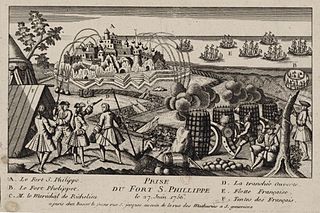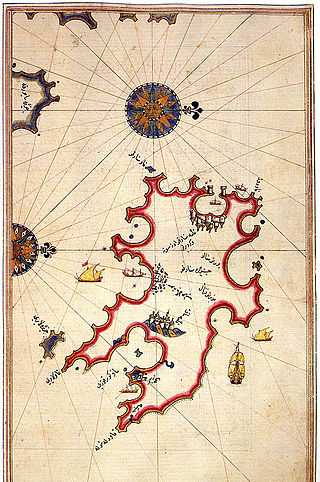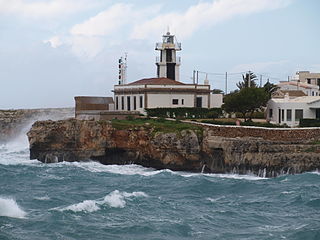
Menorca or Minorca is one of the Balearic Islands located in the Mediterranean Sea belonging to Spain. Its name derives from its size, contrasting it with nearby Mallorca. Its capital is Mahón, situated on the island's eastern end, although Menorca is not a province and forms a political union with the other islands in the archipelago. Ciutadella and Mahon are the main ports and largest towns. The port of Mahon is the second biggest natural port in the world.

Mahón, officially Maó, and also written as Mahon or Port Mahon in English, is the capital and second largest city of Menorca. The city is located on the eastern coast of the island, which is part of the archipelago and autonomous community of the Balearic Islands.

Ciutadella de Menorca or simply Ciutadella is a town and a municipality in the western end of Menorca, one of the Balearic Islands (Spain). It is one of the two primary cities in the island, along with Maó.

Sant Lluís is a municipality on the tip of south-east Menorca in the Spanish Balearic Islands.

St. Philip's Castle was a fortress guarding the entrance to the port of Mahón. It is located in the municipality of Es Castell, on the island of Menorca.

Sanisera was one of the Roman cities located in the island of Menorca, which was mentioned by Pliny the Elder in his book Naturalis Historia, III, 77–78 in the 1st century BC:
The Baleares, so formidable in war with their slingers, have received from the Greeks the name of Gymnasiæ. The larger island is 100 miles in length, and 475 in circumference. It has the following towns; Palma and Pollentia, enjoying the rights of Roman citizens, Cinium and Tucis, with Latin rights; and Bocchorum was a federate town. At thirty miles' distance is the smaller island, 40 miles in length, and 150 in circumference; it contains the states of Jamnon, Sanisera, and Magon.

The Cap de Cavalleria Ecomuseum is an institution which is located on the northernmost coast of Menorca, in the proximity of Cavalleria Cape and the port of Sanitja.

An Ottoman raid of the Balearic islands was accomplished by the Ottoman Empire in 1558, against the Spanish Habsburg territory of the Balearic islands.

The Battle of Menorca took place in the island Menorca between 7 and 9 February 1939 during the Spanish Civil War.

Cala en Bosch, also known as Cala'n Bosch or Cala en Bosc, is a beach, marina, hotel, and apartment resort located on the southwest coast of Menorca, one of the Balearic Islands in Spain. It is situated approximately 9 kilometres south of the town of Ciutadella de Menorca. The area is bordered by the neighborhoods of Son Xoriguer to the east and Cap d'Artrutx, which is the southwestern point of the island and home to the prominent Lighthouse of Artrutx. Cala en Bosch offers scuba diving facilities, making it an attractive destination for underwater enthusiasts.

The Cap d'Artrutx Lighthouse or Artrutx Lighthouse is an active 19th century lighthouse located on the low-lying headland of the same name on the Spanish island of Menorca. It was completed in 1859 but the tower was significantly increased in height in 1969. Automated in 1980, the keeper's accommodation is now used as a restaurant.

The Illa de l’Aire Lighthouse is an active lighthouse on the islet of Illa de l'Aire, on the southeast coast of the Spanish island of Menorca.

The Ciutadella, Punta de Sa Farola or Sa Farola Lighthouse is an active 19th century lighthouse on the Spanish island of Menorca. Originally completed in 1863, the tower has subsequently undergone a number of modifications. It lies close to the seaward entrance of the port of Ciutadella on the Sa Farola point, at the western end of the island. On the opposite headland is the Castell de Sant Nicolau, a 17th-century defensive tower.

The Favàritx Lighthouse is an active lighthouse on the Spanish island of Menorca.

The Punta Moscarter Lighthouse is an active lighthouse, near Portinatx on the northern coast of the Spanish island of Ibiza.

Punta Cumplida Lighthouse is an active 19th century Spanish lighthouse on the Canary island of La Palma in the municipality of Barlovento. Punta Cumplida is the oldest of the four main lighthouses on La Palma, each one being located near to a different cardinal point of the island. Punta Cumplida marks the north-eastern tip; Fuencaliente the southern point, and the two modern lighthouses at Punta Lava and Arenas Blancas, the eastern and western points respectively.

Més per Menorca is a Menorcan political party. It was initially a coalition formed by the Socialist Party of Menorca, the Republican Left of the Balearic Islands, The Greens of Menorca, Equo, local parties and independents around the island until 2017. MpM was created in July 2014. Until May 2017 it had been linked to the similarly-named alliance in Majorca.

USLHT Armeria was a lighthouse tender in commission with the United States Lighthouse Board from December 1890 to March 1898. After Spanish–American War service in the United States Navy as USS Armeria from May to August 1898, she resumed her lighthouse tender duties, first with the Lighthouse Board from 1898 to 1910 and then with its successor organization, the United States Lighthouse Service, from 1910 until she was wrecked in 1912. She was the first lighthouse tender assigned to permanent duty in the Territory of Alaska.


























